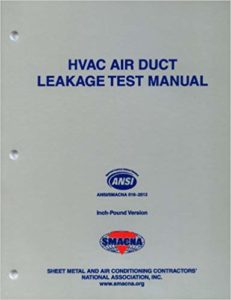HVAC Air Duct Leakage Test Manual
HVAC Air Duct Leakage Test Manual
HVAC Air Duct Leakage Test Manual identifies certain leakage limits for ducts and outlines procedures for testing ducts for conformity with air leakage limits that are set forth in a designer’s project specification. This document is not an endorsement of routine use of testing. Leakage testing is generally an unjustified major expense that is unnecessary when proper methods of assembly and sealing are used. Visual inspection for application of such proper methods will ordinarily suffice for verification of reasonably tight construction. Under any circumstances reasonable allowances for leakage must be adopted because no duct is absolutely airtight.
You can also Read Building Systems Analysis and Retrofit Manual
HVAC Air Duct Leakage Test Manual Content
- Page
![HVAC Air Duct Leakage Test Manual]()
- Foreword
- INTRODUCTION
- RESPONSIBILITIES
- GENERAL PROCEDURES
- LEAKAGE CLASSIFICATION
- TEST APPARATUS
- TEST REPORTS
- APPENDICES
- A: Leakage as Percentage of System Flow
- B: Sample Leakage Analysis .
- C: Suggested Analysis of Non-SMACNA Criteria Specifications
- D: Model Project Specification for Testing .
- E: Leakage Factors for Pressures and Leak Classes
- F: Test Equipment Capacity vs Specimen Size.
- G: Rectangular Duct Surface Area
- H: Round Duct Surface Area
- I: Commentary on Flow Calculation for Orifice Meters
- J: Flow Coefficients K for Orifice Plates with Vena Contracta Taps and Flange Taps
- K: Air Density Correction Factor
- L: Gas Expansion Factor
- M: Properties of Mano metric Liquids
- N: Fluid Meter Instrumentation References
Duct leakage reduces the air quantities at terminal points unless the total air quantity adjusted to compensate. Leakage should be considered a transmission loss in duct systems. The farther air conveyed the greater the loss will be.Key variables that affect the amount of leakage are:
a) Static pressure, not velocity pressure. (The higher the pressure the more leakage will occur.)
b) The amount of duct (the more duct the more opportunity for leakage there will be).
c) The openings in the duct surface (the major contributors are joints and seams although access doors, rod penetrations and fastener penetrations also contribute).
d) Workmanship (poor workmanship undermines the best construction standards).


Comments are closed.